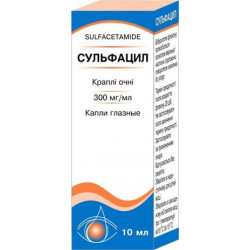



 All payments are encrypted via SSL
All payments are encrypted via SSL
 Full Refund if you haven't received your order
Full Refund if you haven't received your order
Dosage Form
eye drops
Chemical name
N - [(aminophenyl) sulfonyl] acetamide (in the form of sodium salt)
pharmachologic effect
Antimicrobial bacteriostatic agent, sulfanilamide. The mechanism of action is due to competitive antagonism with PABA, inhibition of dihydropteroate synthetase, impaired synthesis of tetrahydrofolic acid, necessary for the synthesis of purines and pyrimidines.
Active against Gram-positive and Gram-negative cocci, Escherichia coli, Shigella spp., Vibrio cholerae, Clostridium perfringens, Bacillus anthracis, Corynebacterium diphtheriae, Yersinia pestis, Chlamydia spp., Actinomyces isinaii, i, i, i, iersinia, foxtheriae, Yersinia pestis, Chlamydia spp.
Pharmacokinetics
With topical application, Cmax of sulfonamides in the cornea (about 3 mg / ml), moisture of the anterior chamber (about 0.5 mg / ml) and iris (about 0.1 mg / ml) is achieved within the first 30 minutes after application. A certain amount (less than 0.5 mg / ml) is retained in the tissues of the eyeball for 3-4 hours. When the cornea epithelium is damaged, the penetration of sulfonamides increases.
Indications for use
Conjunctivitis, blepharitis, purulent corneal ulcer, prophylaxis and treatment of necrosis of the newborn, gonorrheal and chlamydial eye diseases in adults.
Contraindications
Hypersensitivity.
Dosing regimen
Locally, instill 1-2 drops in each conjunctival sac 4-6 times a day. For prophylaxis of neonatal belie, take 2 drops in each conjunctival sac immediately after birth and 2 drops in 2 hours.
Ointment - lay for eyelid 3-4 times a day.
Side effect
Burning, tearing, pain, itching in the eyes, allergic reactions.
Interaction
Combined use with procaine and tetracaine reduces the bacteriostatic effect. Incompatible with silver salts.
special instructions
Patients with hypersensitivity to Furosemide, thiazide diuretics, sulfonylurea, or carbonic anhydrase inhibitors may be hypersensitive to sulfacetamide.
